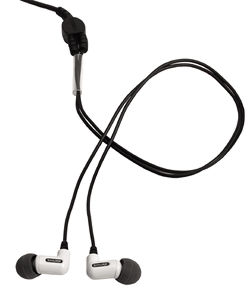| Columns Retired Columns & Blogs |
Shure E3c in-ear headphones
"Ah, I see what the problem is. Your ear canals are larger in diameter than normal."
Size does matter, I guess. I was talking to Shure staffers at their booth at Home Entertainment 2003 last June. I had always had a problem with such in-ear headphones as the industry-standard Etymotics, and was explaining that I was getting on no better with the review samples of Shure's then-new, $499 E5c in-ear cans. With what I now knew to be my wider-than-normal ear canals, I had not been able to get the supplied sleeves, foam or soft plastic, to seal properly. The result was sound that seriously lacked bass.
 Shure then sent me some custom foam sleeves that fixed the problem. More important, they also sent me a pair of the E3c headphones they were introducing at the 2004 CES in January. While the '5s are a seriously good product, the low price of the '3s—just $179—tempted me to write instead about them. (An even lower-priced model, the E2c, costs $99, but the E3c was the one Shure describes in their literature as having "audiophile" aspirations.)
Shure then sent me some custom foam sleeves that fixed the problem. More important, they also sent me a pair of the E3c headphones they were introducing at the 2004 CES in January. While the '5s are a seriously good product, the low price of the '3s—just $179—tempted me to write instead about them. (An even lower-priced model, the E2c, costs $99, but the E3c was the one Shure describes in their literature as having "audiophile" aspirations.)
Inside the head
The Shure use a small earpiece with a protruding tube that fires sound right at the eardrum. A foam or soft-plastic sleeve fits around the tube and seals the ear canal. This both allows the minuscule drive-unit to pressurize the ear cavity, and provides good isolation from external sounds. The drive-unit employs a "balanced armature," which is said to have high efficiency and extended high frequencies. Each E3c is supplied with a Personal Fit Kit, which includes three sizes each of soft and softer plastic sleeves and one pair of yellow foam sleeves. (Refill packs in different sizes are available from Shure's website.) The 60" lead is a bit long for jogging, but an adjuster on the yoke allows it to be comfortably dressed. It is usefully flexible—it would otherwise pick up handling noise—and is fitted with a gold-plated 3.5mm stereo jack. It can be spooled for storage in a small nylon case.
Listening
My one-hour commute allowed me to get some serious auditioning done, using an Apple iPod playing both uncompressed AIF files and 320kbps AAC files. The E3cs were plenty loud straight from the iPod, even on the subway, but I also used HeadRoom's new BitHead amplifier, hooked up to the iPod with its minijack-minijack cable. At home, I used iTunes running on my Apple PowerBook as a source, feeding the Shures from either the headphone jack of a Metric Halo MIO 2882 FireWire-connected D/A converter (with a ¼" adapter) or with the MIO's AES/EBU output feeding the Benchmark DAC 1 (which I write about elsewhere in this issue).
Getting the E5cs to fit comfortably, with their stiff cable and over-the-ear insertion, had been tricky. But the '3cs were easy to fit and didn't feel intrusive. The big adjustment you must make with in-ear cans is to learn to reduce your body's sheer noisiness. With the foam sleeves providing effective isolation from external noise, the sounds of your own footsteps, transmitted through your spine, can become oppressive. And I got used to holding the cable yoke away from my chest lest it, too, communicate body noise.
 Most important, you must get an airtight seal or the E3c will have reduced bass. But when you do get a good seal, the low frequencies sound impressively full. The 1/3-octave warble tones on Stereophile's Editor's Choice CD (STPH016-2) extended in full measure down to the 40Hz band, with the 32Hz tone still audible. The E3cs rolled off rapidly below that frequency, meaning that kick drum sounded better defined, if not as weighty, as with my conventional Sony MDR-7506 phones.
Most important, you must get an airtight seal or the E3c will have reduced bass. But when you do get a good seal, the low frequencies sound impressively full. The 1/3-octave warble tones on Stereophile's Editor's Choice CD (STPH016-2) extended in full measure down to the 40Hz band, with the 32Hz tone still audible. The E3cs rolled off rapidly below that frequency, meaning that kick drum sounded better defined, if not as weighty, as with my conventional Sony MDR-7506 phones.
High frequencies were the E3c's strong suit. Not only was the treble naturally balanced, there was also a refreshing lack of the presence-region emphasis that leads to a "rattling" of massed voices through inexpensive headphones, such as the freebies that came with my iPod. Binaural recordings—a 1980s BBC drama broadcast of She Stoops to Conquer; my excerpt from the 1992 F1 Canadian Grand Prix on Stereophile's Test CD 3 (STPH006-2)—gave impressive out-of-head imaging.
I encountered one operational problem with the E3cs. Their sound-isolating properties were a boon on airplanes, even when the iPod's battery ran down. However, if I inserted them in my ears before takeoff, they would stop working when the plane reached its cruising altitude. It sounded as if the drive-unit had stuck, as turning up the volume resulted in a clipped sound. If I didn't insert the headphones until after the plane's cabin had depressurized, they worked fine. However, I then had to remove them when the plane began its descent.
Summing up
Shure's E3c headphones are comfortable, sound great, and are an excellent value at $179. The E3c is an ideal companion to Apple's iPod, which continues to impress nine months after I purchased it.
- Log in or register to post comments




































